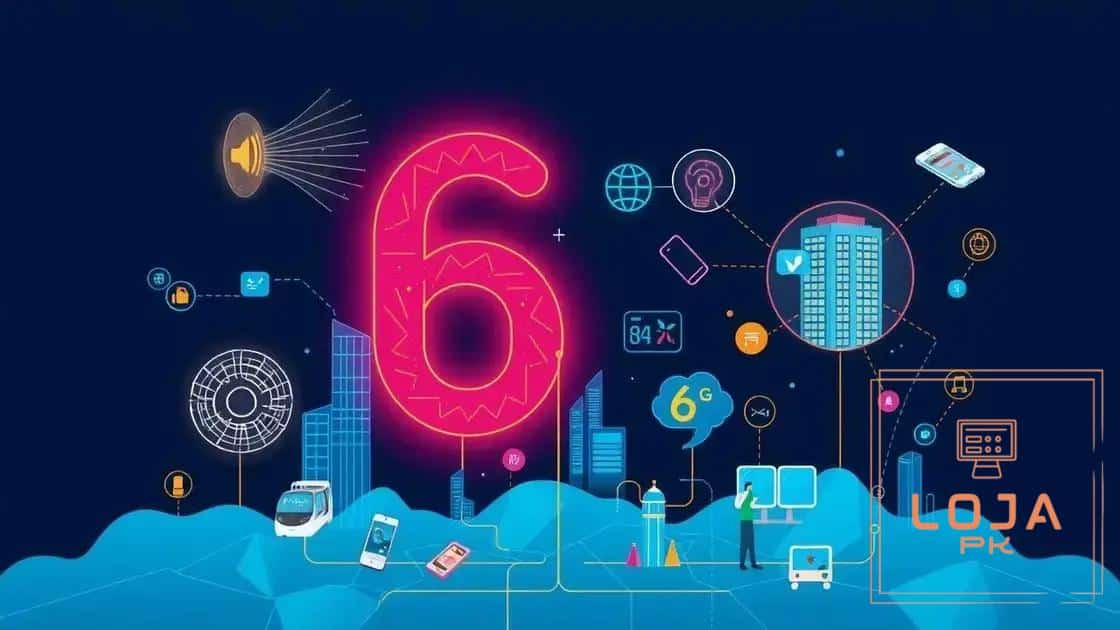Early tests show strong potential for 6G networks

Early tests show strong potential for 6G networks to revolutionize connectivity with increased data rates, lower latency, and applications in healthcare, transportation, and education, significantly enhancing everyday life.
Early tests show strong potential for 6G networks, hinting at a new era of connectivity. Ever wondered how this technology could change our daily lives and industries? Let’s dive in.
Understanding the basics of 6G technology
Understanding the basics of 6G technology is essential as we step into a future of enhanced connectivity. As technology advances, we are on the brink of the next generation of wireless communication, which promises to revolutionize the way we connect and interact with the world.
6G is expected to bring significant improvements over 5G, including faster speeds, lower latency, and more reliable connections. This new technology aims to support not only mobile communications but also a wide range of applications such as smart cities, autonomous vehicles, and the Internet of Things (IoT).
Key Features of 6G Technology
Several key features set 6G apart from its predecessors:
- Increased Data Rates: 6G technology may reach speeds up to 100 times faster than 5G.
- Ultra-Low Latency: Expect latency as low as 1 millisecond, making real-time communication seamless.
- Enhanced Connectivity: Support for billions of devices will be essential as IoT continues to expand.
This technology aims to integrate artificial intelligence and machine learning to optimize networks automatically. As a result, users can expect a more personalized experience tailored to their specific needs. Moreover, 6G will utilize higher frequency bands, enabling faster data transmission but also requiring advanced technologies to effectively manage these frequencies.
Potential Applications
The possibilities with 6G technology are vast. Some expected applications include:
- Smart Infrastructure: Cities equipped with smart sensors and connectivity will manage resources efficiently.
- Telemedicine: Remote healthcare services will improve with high-quality video and data transmission.
- Virtual and Augmented Reality: Enhanced AR/VR experiences will be possible, creating immersive environments for users.
With all these advancements, 6G technology doesn’t just aim to connect devices; it aims to connect people. As we continue to explore the potential of this transformative technology, it invites us to think about how we can harness its power to improve our lives and communities.
Key advancements over previous generations

Key advancements over previous generations are essential to understanding why 6G is poised to transform the technology landscape. As we transition from 5G to 6G, it’s vital to recognize the significant improvements that this new standard will introduce.
The advancements in 6G technology are not just incremental. They represent a fundamental shift in how we think about connectivity. One of the most exciting aspects of 6G is its potential to connect virtually everything, from devices to infrastructure and beyond.
Technological Enhancements
Several technological advancements will define 6G:
- Terahertz Waves: Unlike 5G, which primarily uses millimeter waves, 6G will leverage terahertz frequencies, enabling extremely high data rates.
- AI Integration: Enhanced artificial intelligence will play a huge role in managing network efficiency and user experiences.
- Full-Duplex Communication: 6G will allow for simultaneous data transmission and reception, improving overall communication efficiency.
Moreover, 6G will focus on sustainable development by incorporating energy-efficient technologies. These innovations aim to reduce environmental impact while enhancing network performance. Reliability and security will take center stage, ensuring that users can trust their connections.
Expanded Capabilities
Another major advancement in 6G is its enhanced capabilities:
- Massive Connectivity: 6G aims to support a trillion devices, enabling seamless interactions between people, machines, and services.
- Enhanced Mobile Broadband: Users can expect faster downloads and smoother streaming, even in dense urban environments.
- Ultra-Reliable Low Latency Communication: This will enable applications like remote surgeries and real-time autonomous driving.
The improvements in coverage will also be remarkable, with networks penetrating deeper into rural and hard-to-reach areas. As businesses and services rely on these networks, the shift from traditional connectivity to a more immersive experience will redefine user interactions.
Potential applications of 6G in everyday life
Potential applications of 6G in everyday life promise to reshape how we interact with technology daily. With the advancements brought by 6G, we can expect significant transformations in various sectors, making our lives easier and more connected.
One of the most exciting potential applications is in smart transportation. Picture a world where autonomous vehicles communicate in real-time with each other and nearby infrastructure. This could greatly reduce traffic accidents and optimize traffic flow, making commutes faster and safer.
Enhanced Remote Work and Learning
With the rise of remote work and online learning, 6G can enhance these experiences:
- High-Quality Video Conferencing: Expect crystal-clear video and audio with minimal latency, making virtual meetings feel almost in-person.
- Seamless Collaboration Tools: Teams can work together on complex projects in real-time, regardless of location.
- Interactive Learning Experiences: Students will benefit from immersive content and virtual classrooms that are engaging and dynamic.
Health care is another sector that stands to gain immensely from 6G. Telemedicine can reach new heights, allowing healthcare providers to monitor patients remotely with high precision. Imagine doctors diagnosing conditions using real-time data from wearable devices or conducting virtual check-ups with ultra-low latency.
Smart Homes and IoT
6G will also revolutionize smart home technology:
- Connected Devices: Appliances will communicate seamlessly, leading to energy efficiency and convenient living.
- Enhanced Security: Intelligent security systems can provide real-time alerts and remote monitoring.
- Personalized Home Environments: Smart technology will adapt to individual preferences, creating comfortable living spaces.
In entertainment, 6G will enable immersive experiences such as augmented and virtual reality. Users can enjoy enhanced gaming and interactive experiences that are more engaging than ever before. Content streaming will also reach new levels, delivering high-definition media with no buffering.
Challenges in developing 6G networks

Challenges in developing 6G networks are significant and must be addressed to realize the full potential of this technology. While 6G promises remarkable advancements, various hurdles stand in the way of its implementation.
One major challenge is the need for new infrastructure. As 6G utilizes higher frequency bands, this requires more antennas and base stations. Existing telecom frameworks may need extensive overhauls to accommodate these changes. Furthermore, the deployment of this infrastructure can be costly and time-consuming, deterring some companies from investing adequately in the necessary upgrades.
Regulatory and Standardization Issues
Additionally, regulatory frameworks must evolve to support 6G networks:
- Global Standardization: Different countries may adopt varied standards, creating challenges for interoperability.
- Spectrum Allocation: Finding and allocating the best frequency bands for 6G can be complex, involving negotiations among many stakeholders.
- Policy Development: New policies must ensure that the technology remains secure, transparent, and equitable for all users.
Another challenge involves security. With the increase in connectivity comes the risk of cybersecurity threats. As more devices connect to networks, ensuring the safety of data and privacy becomes crucial. The complexity of 6G networks may introduce more vulnerabilities that bad actors can exploit.
Technological and Environmental Challenges
Technologically, developing advanced hardware that can support 6G capabilities is a daunting task:
- Research and Development: Innovative materials and components must be developed to handle terahertz frequencies efficiently.
- Energy Efficiency: As demand grows, maintaining low energy consumption while expanding capabilities is vital.
- Environmental Impact: The rollout of new infrastructure may have ecological effects that need careful consideration and mitigation plans.
While these challenges may seem daunting, they also present opportunities for innovation and collaboration. The journey toward 6G networks will require cross-industry partnerships, investment in research, and ongoing dialogue among stakeholders to overcome these barriers and unlock the technology’s full potential.
Future outlook: What to expect from 6G
Future outlook: What to expect from 6G is an exciting topic as technology continues to evolve rapidly. As we look forward to the next generation of wireless communication, various advancements will shape our everyday lives and industries.
One major expectation is the integration of artificial intelligence within 6G networks. AI will help optimize data traffic and improve user experiences by personalizing services. This means users can expect smarter connections that adapt to their needs, enhancing the overall functionality of connected devices.
Transformations in Industries
Different sectors will experience significant transformations:
- Health Care: Telemedicine will become more efficient, allowing doctors to monitor patients in real-time and provide timely care.
- Transportation: Expect advances in autonomous vehicles, with improved communication between cars and infrastructure for safer travel.
- Education: Virtual classrooms will offer interactive and engaging learning experiences that reach students globally.
As 6G technology develops, it will also push the boundaries of virtual reality (VR) and augmented reality (AR). Users will enjoy immersive experiences in gaming, training, and social interactions, blending the physical and digital worlds seamlessly.
Environmental and Economic Impact
The rollout of 6G may also lead to a more sustainable future. With advancements in technology, networks will be designed to minimize energy consumption and support green practices. Companies will focus on eco-friendly solutions that reduce their carbon footprint.
Economically, the introduction of 6G is likely to create new job opportunities across sectors. As industries adapt to this new technology, the demand for skilled workers in fields like cybersecurity, network management, and data analysis will soar. The innovation potential in product development and services will flourish.
In conclusion, the future outlook for 6G is filled with promise. From enhancing connectivity to transforming industries, the next generation of wireless networks is set to revolutionize our world in ways we have yet to fully grasp.
The advancements in 6G technology are set to transform our lives in many exciting ways. As we look to the future, we can expect enhanced connectivity, smarter applications, and a more sustainable approach in various industries.
With the integration of artificial intelligence and the rise of immersive experiences, the potential for innovation is limitless. While challenges remain, the collaborative efforts among stakeholders will pave the way for a brighter, more connected future. By embracing these changes, we can maximize the benefits of 6G, making our daily lives more efficient and enriching.
FAQ – Frequently Asked Questions about 6G Technology
What is 6G technology?
6G is the next generation of wireless communication technology that will provide faster speeds, lower latency, and improved connectivity for billions of devices.
How will 6G enhance everyday life?
6G is expected to revolutionize daily life by improving telemedicine, smart transportation, immersive education, and significantly enhancing communication experiences.
What are some challenges in developing 6G?
Challenges include infrastructure upgrades, regulatory issues, ensuring security, and developing energy-efficient technologies to handle new demands.
When can we expect 6G to be available?
While 6G is still in the research and development phase, initial deployments are anticipated around 2030, with full implementation likely to take several years beyond that.





